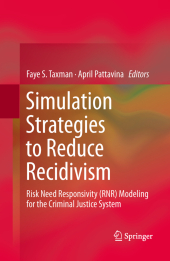 Neuerscheinungen 2015Stand: 2020-02-01 |
Schnellsuche
ISBN/Stichwort/Autor
|
Herderstraße 10
10625 Berlin
Tel.: 030 315 714 16
Fax 030 315 714 14
info@buchspektrum.de |

April Pattavina, Faye S. Taxman
(Beteiligte)
Simulation Strategies to Reduce Recidivism
Risk Need Responsivity (RNR) Modeling for the Criminal Justice System
Herausgegeben von Taxman, Faye S.; Pattavina, April
Softcover reprint of the original 1st ed. 2013. 2015. xi, 315 S. 30 SW-Abb., 30 Tabellen. 235 mm
Verlag/Jahr: SPRINGER, BERLIN; SPRINGER NEW YORK; SPRINGER 2015
ISBN: 1-493-90205-9 (1493902059)
Neue ISBN: 978-1-493-90205-7 (9781493902057)
Preis und Lieferzeit: Bitte klicken
This comprehensive work provides a central source of information and analysis on the current state of simulation modeling in criminal justice, an overview of existing techniques, as well as cases of success and directions for future development.
The use of simulation modeling in criminal justice dates back to the 1970s. Early models were developed to capture the realities of the criminal justice system, to identify what changes were needed, and how small changes would affect the overall picture. Significant time and effort were devoted to these projects and although they achieved some success, the complex nature of the criminal justice system and the difficulties associated with improving and maintaining the models prohibited wide spread adoption in the field. Some of the problems with early simulation projects were the lack of data to validate models, the lack of technical skills needed by staff to design and build the models, and the technical difficulties with software programming to transform models into computerized representations.
As simulation modeling has becoming a more popular technique across many disciplines, and technology as well as the technical skills of researchers has improved, this book revisits the concept of simulation modeling with new applications for the criminal justice system. The wider availability of data has made for more opportunity to verify and validate models; computing software has become more available and easier to use; and the capacity for visualization and communication of models shows promise for the future of simulation in criminal justice.
The time has come to examine the past, present, and future contributions of simulation modeling to the field of criminal justice. This work provides a central resource of information for the current state of simulation modeling, and overview of existing techniques and cases of success, and directions for future development. This work will be an important resource for researchers in criminal justice and related fields, as well as those studying policy-related topics.
Introduction.- The Stages of Simulation Models in Criminal Justice.- Simulation Language, Software, and Data Needs.- Using Simulation Methods to Estimate the Cost of Policy Choices.- A Dynamic Systems Approach to Examining Sentencing Alternatives.- Assessing Correctional Treatment Outcomes with Simulation Techniques.- A Discrete-Event Simulation Model of Heroine Use and Treatment Over the Lifecourse.- Using Evidence-Based Research to Inform Model Assumptions.- Developing Synthetic Data for Criminal Justice Simulation.- The Growing Use of Simulation Techniques by Sentencing Commissions.- Creating and Sustaining Organizational Support for Simulation Use.- Maintaining Agency-Based Simulation Models.- The Benefits of Using Simulation from Criminal Justice Education.
April Pattavina, Ph.D. is an Associate Professor in the Department of Criminal Justice and Criminology at the University of Massachusetts Lowell. Dr. Pattavina has written extensively on the use of technology in the criminal justice system. Faye S. Taxman, Ph.D.is a University Professor in the Criminology, Law and Society Department and Director of the Center for Advancing Correctional Excellence at George Mason University. Dr. Taxman has over 30 years of experience in conducting research in the areas of sentencing, courts, corrections, and organizational change.


